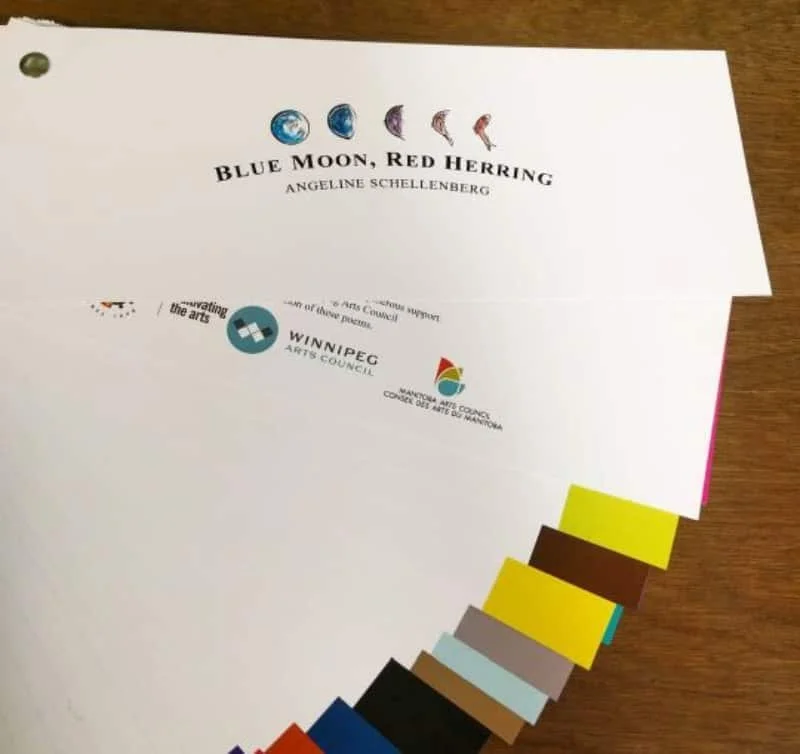Book: Blue Moon, Red Herring
By Angeline Schellenberg
Published by JackPine Press
Review by Shelley A. Leedahl
$30.00 ISBN 978-1-927035-39-9
Clever, layered, original, fun. These words leap to mind after reading Winnipeg poet Angeline Schellenberg’s colourful limited-edition chapbook—bound to resemble a paint swatch—Blue Moon, Red Herring. Each of the twenty-five prose poems in this 2019 collection were inspired by a colour, and the colours themselves appear where a Contents page normally would. No need for titles when the paint-chip colours do the work, and each poem’s colour-matched with its sample. What results is candy—for the eye and the mind.
Schellenberg employs a kind of controlled stream-of-consciousness in these delightful and deceptively simple poems, but don’t be fooled: much research went into this. My best analogy: microwaved popcorn. The poet’s hue-inspired thoughts seem to pop around, but they stay “in the bag” of her theme, and each poem’s written in a single controlled paragraph. Colours aside, Schellenberg’s myriad references are gleaned from art, literature, science, nature, religion, history, philosophy, pop culture, advertising slogans, cliché’s and personal experience, and this rich gallery of inspirations makes for genius mélanges.
In “Magenta” she writes: “like soul mates and democracy, magenta exists only in your mind”. We also get a miniature history lesson: “The French dye, christened for the fuchsia flower, was renamed for Napoleon III’s victory near Magenta, Italy”. Her piece “Chartreuse” demonstrates her wild juxtapositions: the colour “coats the roots of grass you chewed at recess,” it’s “the heart of an avocado,” and it’s “the VW van we could push-start to Mexico, a bed of Scotch moss where you could lay me down”.
It's often the final line of a poem that matters most; get it right, as in the “VW/Mexico/Scotch moss” line above, and the whole poem sings. Schellenberg’s also been published by the venerable Brick Books and her work’s earned much critical attention; she knows the import of endings—and wit. “Grey” ends with: “It’s what comes out in the wash. It takes no responsibility for teenaged boredom, or ashen faces aging with regret”. “Beige” is “Less kinky than khaki”. And, still on “Beige”: “Comfy as dumplings and oatmeal, while they say you can be beiged to death, deep down you know it would be completely painless”.
More highlights: “Maroon” is “old blood” and “your Valentine bouquet by March”.
“Black” is “Any depressed typewriter key, the raised flag of punk and piracy”.
“Orange” recalls “A Fanta on the cabin step, the pulled Fortrel curtains in a rocking van”. Among several other things, “White” spawns “a president’s home” and “the satin clinging to your ankles at your first communion”.
In “Purple” there are literary references (“and when I am old, I shall purr” and, for kids, “Dora’s backpack”) and an allusion to an old song (“One-eyed, one-horned, hazy and a heart of courage”).
“Red” is especially good and nuanced. It includes “The rainbow’s highest arc to trace the words of Christ,” “A can of bull says charge it” (triple-entendre?), and it “Fan’s revolution’s fame”.
This book gets all the stars for originality and wordplay. I wish I’d written it.
THIS BOOK IS AVAILABLE AT YOUR LOCAL BOOKSTORE OR FROM THE SASKATCHEWAN PUBLISHERS GROUP WWW.SKBOOKS.COM.

